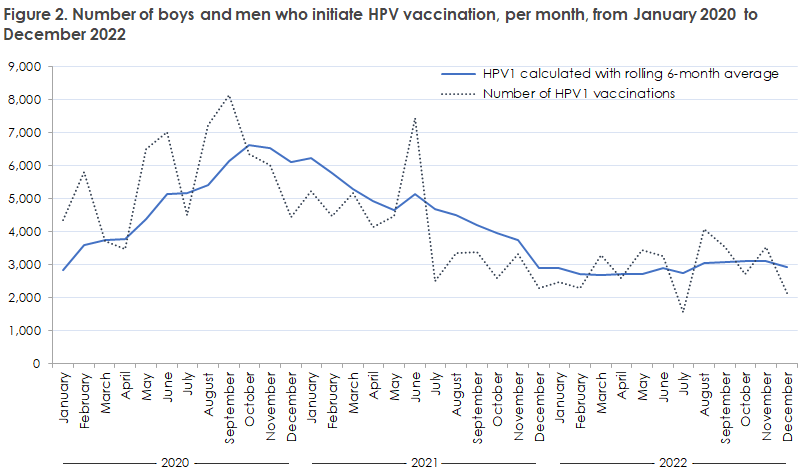No 8/9 - 2023
Update on the HPV vaccination programme
Update on the HPV vaccination programme
As part of the childhood vaccination programme, children aged 12 years are offered vaccination against human papilloma virus (HPV). Vaccination protects against cervical cancer, anal cancer and genital warts and is given to boys and girls alike. To achieve full protection, the children need to receive two vaccinations in the course of a year.
Studies from Denmark, Sweden and England have shown that the incidence of cell changes and cancer has declined following the introduction of a vaccination programme, thereby showing that vaccination does, in fact, protect against cervical cancer and that vaccination at a young age reduces the risk even further. This underlines the importance of a high-coverage, national vaccination programme.
HPV vaccination coverage
Since the introduction of HPV vaccination for girls in 2009, the coverage of initiated vaccination courses (HPV1) has remained between 85% and 92% (birth year 1996-2009). Generally, coverage declines slightly for the second vaccination (HPV2), where the vaccination coverage lies in the 73-82% range for the same birth years. See Monitoring in numbers, figures and maps.
Boys born after 1 July 2007 have also been offered HPV vaccination as part of the childhood vaccination programme. Additionally, boys born between 1 January 2006 and 30 June 2007 have been offered vaccination as part of a catch-up programme. For those full birth cohorts of boys who have been offered vaccination (2008-2009) and who may therefore be compared with the same cohort of girls, the coverage is 89% and 86% for HPV1, respectively. Whereas 79% and 73%, have concluded the full vaccination course.
The latest full birth year that has been offered HPV vaccination is children born in 2010. Data from 8 February 2023 show that, in this birth year, 82% of the girls and 80% of the boys have initiated their vaccination course. The percentage of concluded vaccination courses cannot be estimated yet, since a five-month interval is required between the two vaccinations.
Decline in HPV vaccination coverage
Statens Serum Institut has previously described that HPV vaccination coverage has remained high even during the COVID-19 epidemic (EPI-NEWS 10/2021). However, the latest data from the Danish childhood vaccination programme show that the share of children vaccinated against HPV has declined since last year, even though this has not been the case for the other vaccines given after the child’s first year (MMR2 vaccination and DTaP-IPV booster vaccination).
The latest full birth year of HPV vaccinated children that can be analysed is children born in 2009. This birth year was offered the first vaccine when the children turned 12 years old in 2021.
Comparison of data for birth year 2008 in February 2022 with data for birth year 2009 in February 2023 reveals that the HPV vaccination coverage has declined. For initiated vaccination courses, coverage has declined from 91% among girls born in 2008 to 88% among girls born in 2009, whereas the coverage among boys declined from 89% to 86%. For concluded vaccination courses, coverage declined correspondingly from 80% to 76% for girls and from 79% to 73% for boys.
Figure 1 shows the number of girls and women who have initiated a HPV vaccination course per month, from 2012 through 2022. Here, a decline is seen in the number of HPV vaccinations from late 2020 to May 2022, which covers the period during which children born in 2009 were offered vaccination. In May 2022, the number of vaccinations increased once again, which may be because, by then, COVID-19 was no longer considered a critical threat in Denmark, and because society was then gradually returning to normal.

Figure 2 shows the number of boys and men who have initiated a HPV vaccination course per month, from 2020 through 2022. Here, a considerable increase is seen in the average number of HPV1 vaccinations from the introduction of the catch-up programmes for boys in February 2020 which remained in place until 31 December 2021. Following the increase observed in connection with the catch-up programmes, the number of boys and young men who initiated HPV vaccination declined and seems to have normalised around 3,000 monthly vaccinations, which is also the number we normally see for the girls.

HPV2 vaccination among children born in 2009, by area and municipality
HPV vaccination coverage varies considerably between different areas of the country. For girls, the coverage for HPV2 vaccination is highest in West Jutland (80%) and lowest in Copenhagen City (72%). For boys, the highest coverage (75%) was recorded on Funen, and, once more, the lowest coverage was seen in Copenhagen City (69%). See Monitoring in numbers, figures and maps and Figure 3.

In small municipalities, where few children are born each birth, coverage may vary considerably even though the actual number of kids who have yet to be vaccinated or who have been vaccinated, are very low. Therefore, this analysis includes only municipalities in which the number of boys born in 2009 exceeds 100. Among these municipalities, the lowest HPV2 coverage recorded is 59%, whereas the highest is 84%. The ten municipalities with the highest HPV2 vaccination coverage and a birth cohort exceeding 100 boys are: Odder, Egedal, Bogense, Vejen, Holstebro, Kerteminde, Morsø, Roskilde, Billund and Glostrup.
In the same analysis for girls, the municipality with the highest HPV2 coverage reported an 86% coverage, whereas the lowest-scoring municipality recorded a 64% coverage. The ten municipalities with the highest HPV2 vaccination coverage and a birth cohort exceeding 100 girls are: Assens, Hjørring, Ringkøbing-Skjern, Hedensted, Holstebro, Randers, Vejen, Favrskov, Faaborg-Midtfyn and Struer.
It is important to focus on families with children who are not vaccinated as Denmark has yet to comply with the WHO recommendation of a 90% coverage for girls. Read more about vaccination coverage determinants of the vaccination programme in EPI-NEWS 25-26/2021.
(K. Finderup Nielsen, P. Valentiner-Branth, P. H. Andersen, Infection Epidemiology and Prevention)
1 March 2023